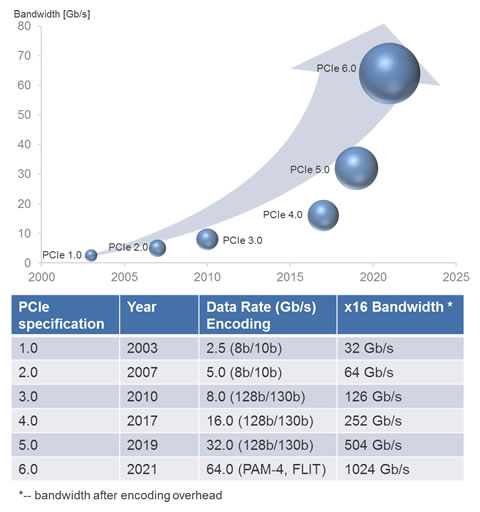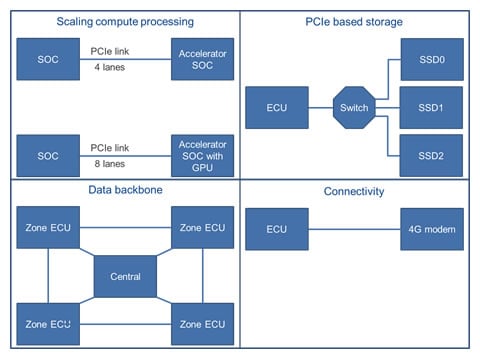PCIe Goes Automotive
I believe every person that has an interest in technical things and computer science has at least once opened his personal computer to check what is actually inside. Besides the big PCB with the CPU, heatsinks and fan on it you may have recognized the extension slots usually located vertically towards the rear of the housing. These are PCI Express® (PCIe®) extension slots in the most popular form factor following the CEM (Card Electromechanical) specification. There are other form factors available with different sizes for different purposes. There is for example the PCI Express M.2 or U.2 connector to connect SSDs or other storage devices or OCuLink plugs for cable connections. For your home PC same as for a supercomputer, PCIe is the most traditional I/O connection for extending functionality where reliable high-speed data transfer is necessary. PCIe is the successor of the also successful PCI and PCI-X standard. One of the main differences between PCIe and its predecessors is that data transfer is today done in a serial manner whereas it was formally done in parallel form. Limitations in synchronizing a parallel bus led already at end of the last century many parallel interfaces to disappear and change to a serial transport mechanism. One example of this transition is the also very popular Centronics interface (IEEE 1284) for printers.

PCIe can be seen as the most successful and mature I/O interconnect that not only offers high speed bandwidth but also reliable transport mechanisms. Since its first release in 2003, the average bandwidth has been doubled every 3 years always maintaining backward compatibility. Right now, PCIe Generation 6 (PCIe gen 6) is developed. Explaining the features and developments in this new version is in the wrong place here. If you are interested in this I recommend taking a look at the video made by Debendra Das Sharma from PCI-SIG Board that goes through the main innovations.
Bandwidth is one thing that makes PCIe popular. PCIe has what is called an “inbuild reliable transport mechanism” which means, the hardware guarantees that the packets that are transmitted do actually go to where they are supposed to go. This is different to what Ethernet is offering where you are using a “fire-and-forget” principle. If you are interested in end-to-end insurance of the transport, you have to use software-driven transport protocols which increase latency and require CPU performance. The built-in error detection and correction mechanisms for packages and transactions are increasing further the reliability of the data transfers. So PCIe takes care on a hardware level about guaranteed package delivery and re-transmissions if necessary.
Another asset of PCIe is the existing eco-system. There are uncountable numbers of PCIe devices out in the market. Everything that requires high-speed data transfer, from Wi-Fi chips through 4G and 5G modems, graphic cards and storage devices. Together with the software, package analyzer, tooling, and compliance programs PCIe makes it easy for developers to use this technology and simply build up even complex systems.
PCIe continues evolving and enjoys support from the industry in the PCI special interest group (PCI-SIG) developing and maintaining the specifications in various working groups. The automotive working group launched at the beginning of 2021 is the latest member of the PCI-SIG family.
Why PCIe is interesting for Automotive?

“With the advent of driver assistance systems and autonomous driving we are now seeing automobiles need the compute power that used to be the domain of supercomputers” Richard Solomon, PCI-SIG Vice president said. And even in models without these new features, PCIe is already used for high-end infotainment systems, for storage of navigation data or as a connectivity solution to a 4G or GNSS modem.
Compared to other communication protocols used in the automotive industry, PCIe uses a totally different communication paradigm. Ethernet, CAN and LIN use a typical sender/ receiver package-oriented method where the sender CPU packs information into a transfer protocol and the receiver unpacks. The DMA-based access method in PCIe allows processors to remotely access data directly without processor interaction on the remote side.
The PCI-SIG has identified 4 use cases where PCIe could have potential relevance to the automotive industry. The use cases listed below are all in the existing key domain of PCIe. What needs to be figured out is, how well PCIe serves in the automotive operation environment.
Use case 1: Scaling compute processing
This use case is a very traditional PCIe one where PCIe is used for Chip-to-Chip communication inside an ECU. The application field could vary from high resolution display processing to image recognition to neural network applications. PCIe allows the building of a modular processing architecture with the scalability and virtualization features provided. Data exchange rates can be increased by adding additional lanes to the PCIe interface without changing the entire application. With this capability, high transfer rates without significant processor interaction are possible. Virtualization support and extended features like SRIOV and ATS give the developers tools at hand that also cover safety and security aspects.
Use case 2: PCIe-based storage
Also, this falls already into the domain of current PCIe applications. There is a need for reliable high-speed data storage due to regulatory requirements for data recording. The storage technology for operation in the automotive environment is existing and offers with PCIe an easy-to-use solution with short development TAT. When storing data, protection and confidentiality regulations for processing, transport and storage have to be considered.
Use case 3: Data backbone
From the keyword, this is as well a common PCIe use case, but the environmental conditions are different. In current PC-based use cases, the distance between two PCIe devices is compared to ECUs in a vehicle rather small. The PCIe standard does not specify a maximum cable length. Today’s available cables typically support connections between two PCIe interfaces with a distance of 5 to 7 meters without re-timers (signal conditioner devices). Sounds long but still does not always meet the required distances inside a vehicle. All this reveals that this communication channel was originally not made for the harsh automotive environment. Adding re-timers can increase the distance but also increase the overall system cost which is a very critical factor in the automotive industry. There are proprietary physical layer solutions available that allow wider distances like HDBaseT. At this point, PCIe competes with other existing networking solutions.
Use case 4: Connectivity
This use case covers for example the connection between the gateway ECU and the Telematic Control Unit (TCU). This could be either a chip-top-chip connection or a long-reach connection depending on the architecture. From a requirements point of view, this use case is a mixture of the 1st and 3rd use-case.
What does PCIe offer to automotive?
PCI-SIG wants to give the automotive industry an additional tool, not necessarily a new tool, at hand to solve the upcoming challenges with respect to the exponential increase of data to be handled in the vehicle.
Besides the technical aspects of speed, eco-system and multi-vendor availability PCIe has an established procedure for compliance testing and certification. Standardized solutions are the most preferred technologies in the automotive industry as they guarantee among others interoperability and support from multiple players in the industry and along with this somehow guaranteed the long-term availability of products and further development of this technology.
The maturity and sustainability of a technology is key for this industry. PCIe is out there for almost 20 years and intends to stay for the next decades. Setting up a working group specialized to investigate the future needs of the automotive industry is the right step to set the usage of PCIe technology in vehicles on a stable foundation. On the other hand, technology development is fast, often faster than any standardization activity can be. Instead of trying to standardize what is already used and what is industries best practice, the focus must be put on future use cases and application fields.
Is PCIe ready for automotive?
PCIe is already used in the vehicle and therefore the first answer to this question is “yes”.
Is PCIe ready to address the intended future use cases with the reliability requirements, temperature ranges, noise, and cable length? The answer is “To find this out the Automotive working group in PCI-SIG was created”.
The Automotive working group led by Intel and Nvidia brings companies and people together with different backgrounds. There are excellent PCIe experts, members with automotive backgrounds, network architects, physical layer experts, and timing experts trying to figure out how PCIe might be used in the future and what challenges and problems may arise using PCIe in the automotive industry.
There are several areas to investigate. First, the environmental conditions in this area are different. The automotive industry has very strict requirements and testing procedures to check against noise and EMI. These need to adopt in the PCIe certification and qualification process. And products need to become widely available certified against automotive standards such as AEQ-100. There is a wide range of products that could meet Grade 3 or 2; the number of options for Grade 1 (up to 125 °C) devices becomes rare. Security is a key requirement, especially for communication interfaces that are exposed outside a closed system like the wiring harness in the car. Since PCIe Generation 5 an extension (Engineering change notice - ECN) to PCIe is available that ensures confidentiality, integrity and replay protection mechanisms for transaction layer packets. Although this ECN was developed based on current industry best practices it needs review and justification from an automotive perspective.
Functional safety is another aspect that requires a deeper look into. PCIe offers already a set of safety mechanisms starting from various CRCs, replay mechanisms to transaction checks with various reporting mechanisms. Products are developed with safety in mind already and are available for different safety levels. System-level analysis will show if the mechanisms provided by PCIe are sufficient or not which is strongly use-case dependent.
What’s missing?
In my view what’s missing at the moment is the active participation of the innovation drivers from the vehicle manufacturer. Historically we knew that it was always difficult to get them into those standardization activities. Some innovative solutions are currently considered to allow them to give input without the need of complicated IP-bylaw and antitrust negotiations.
Renesas Contribution
Renesas is a member of the PCI-SIG since its early days and actively participated in the standard development which is reflected in products offered by Renesas for the industrial as well as for the automotive field. The product range covers clock generators, re-timers and processors with integrated switch, root-complex and endpoint functions.
When the automotive working group was announced we quickly decided to join with the aim of continuing the support towards our customers and driving standardization development for this new era. The working group was established in March 2021 with no tangible conclusion as of today on what enhancements are necessary to the PCIe standards. We are committed to PCIe and to the innovative changes required by our customers towards new applications in the automotive industry. The necessary enhancements will be reflected in our PCIe product line-up.
